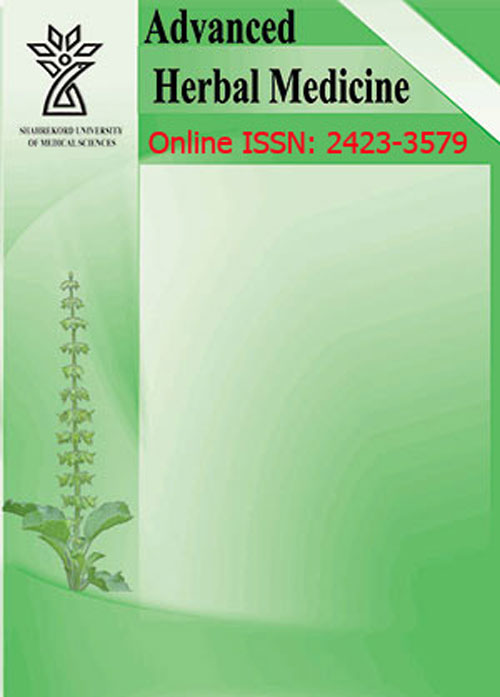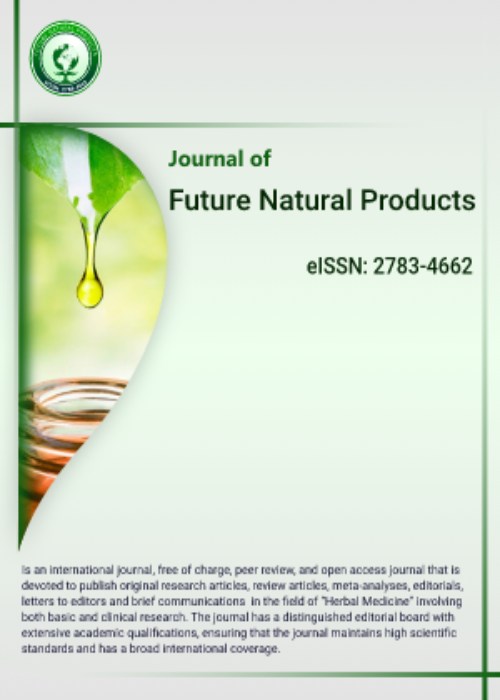فهرست مطالب

Future Natural Products
Volume:4 Issue: 2, Spring 2018
- تاریخ انتشار: 1397/03/16
- تعداد عناوین: 7
-
Pages 1-6Background and aimsResistance of bacteria against antibiotics has always been a prevalent problem in medicine. So, finding new antimicrobial compounds with least side effects seems to be necessary. This paper aims to explore the antimicrobial effects of Thyme, and Aloe vera and Zararia multiflora extracts against Pseudomonas aeruginosa resistant to antibiotics.MethodsThyme, and Aloe vera and Z. Multiflora extracts were obtained by using rotary devices. Twenty samples of P. aeruginosa were collected from the patients being cured in Zabol hospitals. The least hindering and killing concentrations of the samples were calculated by lowering their density in sinks. Sensitivity of P. aeruginosa to the different antibiotics prepared by Padtan Teb Co was evaluated by the diffusion disk standard method proposed by Kirby Bauer. Data were analyzed statistically by determination of significant difference using analysis of variance (ANOVA) test. All tests were analyzed at the significance level P<0.05.ResultsOur results have shown that Aloe vera hinders the growth of bacteria in various concentrations. Despite the relative resistance of most of the samples in the used concentrations, the highest sensitivity was observed in 10 and 20 mg/l. Approximately, Aloe vera extract has shown the highest hindrance effect in 5 mg/l. Further, the highest sensitivity to Z. Multiflora was in 10 and 20 mg/l in which 100% of the bacteria were killed. Approximately, Z. Multiflora of 5mg/l had the highest resistive effect.ConclusionThyme, and Aloe vera and Z. Multiflora extracts have considerable antimicrobial effect on the samples of the P. aeruginosa resistant to antibiotics.Keywords: Antimicrobial effects, Antibiotic resistant, Pathogens, Plant extract
-
Pages 7-15Background and aimsStaphylococcus aureus is an important contaminant of milk and dairy products. It can cause a wide range of illnesses including, food poisonings and nosocomial infections. The aim of this study was to compare the antimicrobial effects of the essential oil , aqueous extract and powder of the Satureja bachtiarica on staphylococcus aureus.MethodsSatureja bachtiarica was collected from the heights of the province of Chaharmahal va Bakhtiari and its extract and essential oil were collected. The bacteria staphylococcus aureus was obtained from the Iranian Research Organization for Science and Technology. The bacterium was inoculated in equal amounts to specimens of cream cheese; afterward different concentrations of the essential oil , aqueous extract, and herbal powder were produced and inoculated in in equal amounts to the cream cheese specimens; subsequently, the specimens were checked 20, 40 and 60 days after inoculation. In the end, the microbial activity of the essential oil , aqueous extract and herbal powder were reported according to mg/ml.ResultsThe minimum growth of the bacteria staphylococcus aureus was observed in the 1000 milligram concentrations of essential oils and 125 mg of the aqueous extract and 125 mg of powder of the plant. At all the concentrations tested the pH changes in the fortieth day, and the changes in the rigidity of the cream cheese specimens were significant as well. At some of the concentrations of the aqueous extract and some concentrations of the herbal powder the changes in the texture of the cream cheeses, comparing to the controls, were significant.ConclusionThe essential oil , aqueous extract and powder of the Satureja bachtiarica have a great inhibiting effect on the growth of the bacterium staphylococcus aureus. Thus, it can be used as a natural preservative in foods with high lipid content.Keywords: Essential oils, Satureja bachtiarica, Staphylococcus aureus, Extracts, Powder
-
Pages 16-25Background and aimsTo analyze the pharmacognostic characteristics and physiochemical parameters of the leaves of Gomphrena serrata (G. serrata).MethodsMicroscopic characters and powder analysis had been carried out with the help of a microscope. The physiochemical properties such as loss on drying, total ash value, acid insoluble ash value, water soluble ash value, extractive values and fluorescence of G. serrata had been performed.ResultsMacroscopically, the leaves are simple, elliptical in shape, rounded or obtuse apex with an entire margin. Microscopically, the leaf showed the presence of epidermal cells with uniseriate multicellular covering trichomes and anomocytic stomata, followed by 1-2 layered collenchymatous cells and 10-15 numbered conjoint, collateral closed vascular bundles are some of the diagnostic characteristics observed from an anatomical study. Powder microscopy of leaf revealed the presence of uniseriate multicellular covering trichomes, lignified xylem vessels, epidermis with anomocytic stomata and parenchyma cells. The investigations also included leaf surface data i.e., quantitative leaf microscopy and fluorescence analysis. Physiochemical parameters such as loss on drying, extractive values and ash values were also determined. Preliminary phytochemical screening showed the presence of flavonoids, alkaloids, tannins, steroids, carbohydrates, glycosides, amino acids and proteins.ConclusionThe morphological, microscopical and physicochemical parameter results provided in this paper may be utilized as a basis for the preparation of a monograph on G. serrata leaves.Keywords: Pharmacognostic, Gomphrena serrata, Anomocytic stomata, Lignified xylem vessels, Phytochemical, Physicochemical analysis
-
Pages 26-32Background and aimsCoinciding with the rise of human population, the use of medicinal plants began by ancient peoples as medicine, poison, detergent, food and paint upon it.MethodsIn present study, the chemical composition and antioxidant activity of Shirazi thyme, T. vulgaris, essential oil was analyzed by three methods (DPPH, potassium ferricyanide reaction and CUPRAC methods) and comparison with TBHQ method for determination of reducing power of T. vulgaris essential oil by potassium ferricyanide method. Phytochemical composition of T. vulgaris essential oil was identified by GC/Mass device.ResultsThe results showed that T. vulgaris essential oil has a good potential against oxidants even near to TBHQ. The essential oils of this plant are Thymol (40.02%) and Carvacrol (18.31%).ConclusionThe results of antioxidant activity of Thymus vulgaris using three methods and comparison with TBHQ (Tertiary butyl hydroquinone) showed Thymus vulgaris essential oil have a good potential for scavenging of free radicals similar to TBHQ.Keywords: Thymus vulgaris, Antioxidant Activity, essential oil, GC, mass, TBHQ
-
Pages 33-47Background and aimsThis study investigates the kinetics of inhibitory activities of ethyl acetate leaf fraction of Lecanodiscus cupanoides on 𝛼-amylase and 𝛼-glucosidase.MethodsThis was done using 𝛼-amylase and 𝛼-glucosidase enzymes from Aspergillus oryzae and Saccharomyces cerevisiae respectively, active component and antioxidants capabilities of the fraction were also analyzed.ResultsThe fraction scavenged DPPH, OH*, and ABTS+ and chelated Fe2+ with the IC50 values of 0.46, 0.70, 0.75 and 0.97 mg/mL respectively. However, significant and mild inhibitory effect was also observed in 𝛼- amylase and glucosidase with IC50 values (0.73 and 0.58 mg/mL) in concentration dependent pattern. Kinetic analysis of the fraction revealed an uncompetitive and non-competitive mode of inhibition for 𝛼-amylase and 𝛼-glucosidase respectively.ConclusionThis study suggests that ethylacetate fraction of this plant possesses antidiabetic property as a result of its ability to inhibit the metabolism of carbohydrate hydrolyzing enzymes. The elicited activities of the ethyl acetate fraction Lecanodiscus cupanoides may be due to the presence of phytochemicals of utmost pharmacological importance present in the fraction.Keywords: Acarbose, diabetes, Hyperglycemia, Postprandial Hyperglycemia, Radical Scavenging
-
Pages 48-50
Bone repair is a condition for which conventional Western-style medicine offers “no treatment” (beyond stabilization and adequate calcium uptake). The present discussion has consciously gone beyond the Cochrane levels of certainty, and has preferred to look to cutting-edge clinical inference drawn from animal or human studies, with the over-riding limitation of first doing no harm.
Keywords: bone-repair, herbal, holistic, PTHrP (ParaThyroidHormone-relatedProtein) -
Pages 51-64Background and aims
The kidney is a very vital organ that is responsible for regular elimination of unwanted substances from the body. It is frequently exposed to conditions that expose it to damage. There are not enough drugs in the market to protect or treat the kidney against these deleterious conditions. Homalium letestui has been used in traditional medicine as an antidote. This study aims to investigate the nephroprotective activity of ethanol stem extract of Homalium lestetui against gentamicin-induced rat’s kidney injury.
MethodsThirty-six (36) adult male albino rats were used for this study. Animals in group I served as the control with normal saline, group II received gentamicin (100 mg/kg), group III received Silymarin (100 mg/kg), while group IV, V and VI where administered 250, 500 and 750 mg/kg of ethanol stem extract of Homalium letestui along with gentamicin 100 mg/kg for 8 days. The nephroprotective effect of the extract was evaluated by the assay of kidney function parameters such as serum urea, creatinine, electrolytes (K+, Na+, Cl- and HCO-3) and histopathological examination of the kidney.
ResultsHomalium letestui caused significant p≤ 0.05 dose-dependent reduction in the level of serum urea, creatinine, and electrolytes in rat’s kidney when compared to the control. The chemical pathological changes were consistent with histopathological observations suggesting marked the nephroprotective effect of the stem extract of H. letestui.
ConclusionThe result of the study suggests that the plant has kidney protective ability which supports its traditional use as an antidote
Keywords: Homalium letestui, nephroprotective, rats


